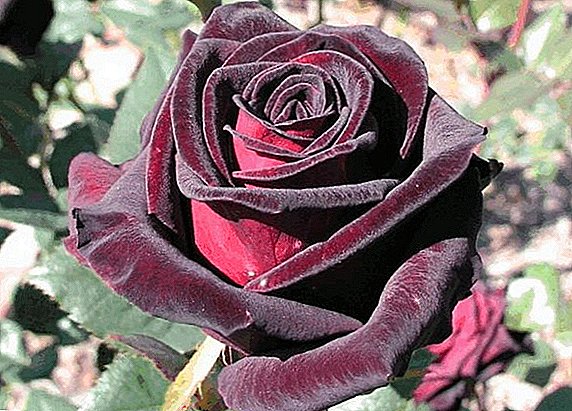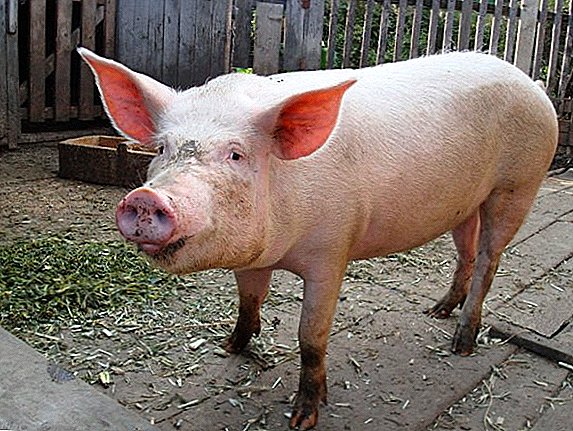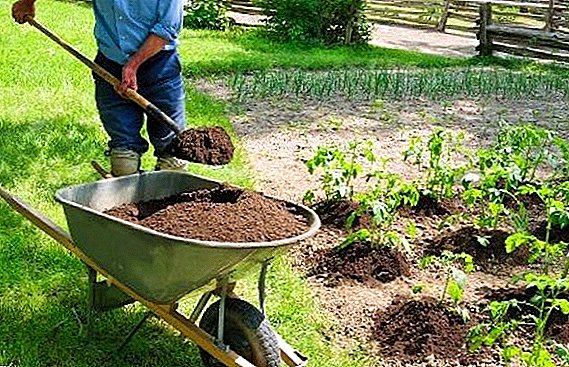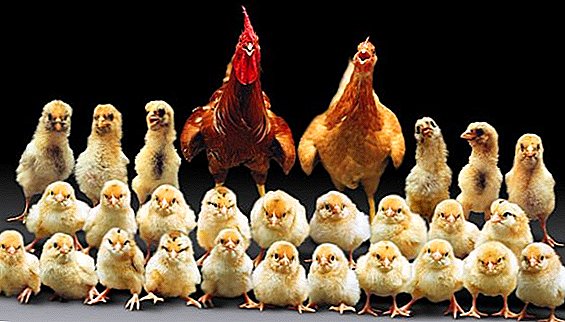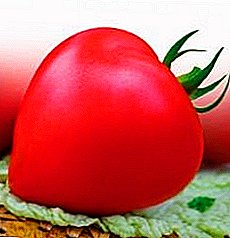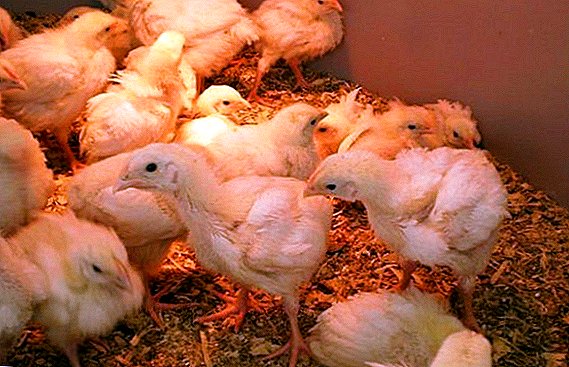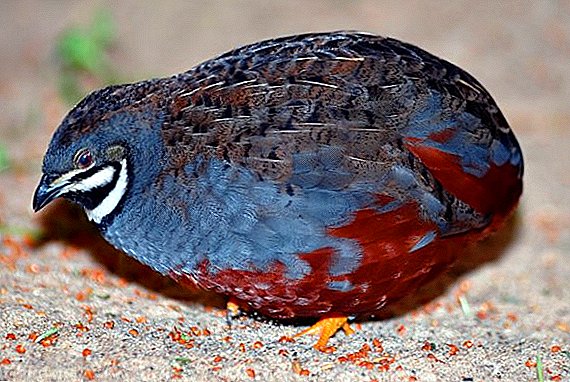 Breeding in private farms Chinese painted quail is becoming increasingly popular occupation. A couple of dozens of these small birds can diversify the diet of a small family with eggs and dietary meat. Let's see what conditions need to be created for the successful maintenance of the Chinese quail.
Breeding in private farms Chinese painted quail is becoming increasingly popular occupation. A couple of dozens of these small birds can diversify the diet of a small family with eggs and dietary meat. Let's see what conditions need to be created for the successful maintenance of the Chinese quail.
Description
Chinese quail (Latin name Chinenesis coturnix) belongs to the family of pheasants. In the wild, varieties of Chinese quail live in the Asian part of the globe. 
External features
These are small birds, the weight of the largest specimens does not exceed 45 g. The males of this breed have a very colorful and bright feather outfit, the females are gray and inconspicuous. Birds are kept in households as a decorative breed of birds, as well as for eggs and meat. Quail eggs in many countries are considered to be a delicious food.
Did you know? Japanese quail eggs (Coturnix japonica) have been successfully incubated on the Mir space station. In space, small quails were safely born from the incubator.
Gender Differences
Sexual dimorphism:
- the female is smaller than the male;
- males are colored brightly, and females have a nondescript "outfit".
The natural color of the male is dark brown with a blue-gray chest and a gray-brown tinge on it, the belly is painted in dark red, the neck is black, with white and black stripes. Lighter shades of brown may also be present in the coloration, which are distinguished by a motley pattern on the feathers of the wings. 
Coloring the female:
The female does not have a colorful coloring of the male. It has brown feathers with rusty brown color of the abdomen and breast. In females and males there are black beaks, orange or yellow legs and a short dark brown tail.
Body length:
female - 12.5 cm;
male - up to 14 cm.
Wing Length:
female - from 66 to 67 mm;
male - from 65 to 78 mm.
Learn how to properly feed quail.
Tail length:
female - 20-22 mm;
male - about 25 mm.
As a result of the selection, a Chinese quail with silver colored feathers was also bred. Males and females of the newly created species have the same feather cover color.
Important! If the Chinese quail began to fall fluff and feathers, this is a signal to the fact that there are drafts in the room where they are kept. The poultry farmer needs to eliminate the gaps that the draft penetrates, or send fans to the other side to ventilate the room.
Distribution in the wild
This little exotic bird is widespread in Asia. It can be found in India, in Ceylon, in the Far Eastern regions of China, in the Indonesian archipelago and in New Caledonia.  Chinese quails live in rice fields and swampy plains, where they find food consisting of wild seeds and grain crop residues, sometimes small insects. Living on vast flat spaces, birds feel safe from the attack of predators.
Chinese quails live in rice fields and swampy plains, where they find food consisting of wild seeds and grain crop residues, sometimes small insects. Living on vast flat spaces, birds feel safe from the attack of predators.
Productive characteristics
These birds are very prolific and carry tiny speckled eggs the size of an olive. In our country, quail eggs are considered a delicacy. They are rich in vitamin D and high in antioxidants. Females start laying their first eggs at 6 weeks of age. During the year, the quail carries from 150 to 200 eggs.
Body weight of birds:
- female - 28 g:
- male - 40 g
Did you know? A person needs to eat only two quail eggs a day to get half the daily dose of vitamin D recommended by doctors.
Conditions of detention
Summer content
The greatest difficulty in breeding Chinese quail can be caused by the fact that these birds must be kept outdoors in the summer, and they need heated rooms for wintering. The small size of the birds allows them to winter in large cages and in aviaries.
Summer period they should spend in a street aviary. In the fresh air, tender chickens will be able to bask regularly in the sun and receive their dose of vitamin D. Chinese quails are monogamous birds, therefore they are kept in pairs or small families from the rooster and two or three females.  They breed without problems in captivity. These birds have a tendency to pterophagy (plucking feathers). With too many birds in a cage, stress and poor nutrition - the likelihood of pulling out feather cover rises. Quail, kept in good conditions, is a very peaceful bird and can easily live in a joint aviary with other non-aggressive bird species.
They breed without problems in captivity. These birds have a tendency to pterophagy (plucking feathers). With too many birds in a cage, stress and poor nutrition - the likelihood of pulling out feather cover rises. Quail, kept in good conditions, is a very peaceful bird and can easily live in a joint aviary with other non-aggressive bird species.
Make a cage for quail yourself.
Where to install a summer aviary:
- Summer residence of quail is best located in a secluded corner of the garden.
- To predators did not get to the winged pets from the bottom (making digging and burrows), the aviary should be installed on the concrete floor.
- All open parts of the enclosure should be covered with metal mesh with the smallest cells.
- In order to provide birds with natural shelters, bushes that do not require care, such as boxwood, juniper or low thuja, should be planted inside the cage.
- Quails do not tolerate wind and drafts, therefore, it is worth planting a hedge around the aviary, which will protect them from the northern winds.
- Most of the enclosure should consist of a territory for walking in the fresh air, in a smaller part have a well-insulated sparrower.
- Concrete floors in the open-air cage and in the house are covered with clean yellow sand, sawdust or wood chips.

Did you know? The main enemies for quail are cats, foxes, coyotes, raccoons, hawks, owls and snakes. All of these animals hunt quails and eat their eggs.
Winter content
- A permanent aviary built specifically for quails is an excellent solution if the poultry farmer does not have the opportunity to take quails into the house for the winter. Such a sparrowhouse is made of wood or brick, and its front wall should be glazed in order to have as much light as possible inside. Both walls and roof structures are insulated with polystyrene or glass wool.
- The winter aviary inside is divided into a warm inner and unheated walking part. This requires the separation of the warm part of the house from the cold shields installed from the ceiling to the floor. For this purpose, perfectly fit wooden frames without gaps with a built-in door for the entrance of a poultry farmer who takes care of birds.
- The floor in the aviary is filled with sand or sawdust, 2-3 powerful electric light bulbs are suspended quite low there, several large stones or branches are installed. It is also necessary to ensure that nests are installed under the walls.
- The inner territory for walks is arranged as a small area in the unheated part of the room. A small vestibule is built in front of the entrance door, which additionally warms the room and makes it difficult for cats and other predators to get inside.

Content in the apartment
Quail can be kept in the apartment. For this, a closed balcony or loggia is suitable, where you can install quail cages in several tiers. For breeding quails on a loggia, it is important that this small room be heated and not have drafts.
The number of residents in one cell
Quails live in a couple or a small family, headed by one rooster. Two or three males in one quail family will never make peace; fights will continue until only one cock remains. If the poultry farmer does not intervene in time and doesn’t get extra males out of the cage, then it will end in their death. Quail "harem" may consist of 3-4 females. 
Requirements for the room
The room where quails will be kept (in an open-air cage or cage) must have the following parameters:
- Complete absence of drafts.
- Good lighting - continuously for 18 hours, as well as further alternation of day and night every 2 hours (for 6 hours).
- Compulsory heating and temperature control (not below +10 ° C and not above +25 ° C).
- When shared with other birds - respect for spatial isolation between species.
- Chinese quails require very little space to live. For one bird enough 9-10 cm of space. These are very compact birds with a fast reproduction rate. Therefore, for the device quail farm does not need a large space, the birds live well in cages arranged in tiers at each other.
Did you know? Quails love to take dust or fly ashes to help destroy pests (feather mites) and keep plumage clean.
Lighting
Large farms in the winter time contain quails with 18-hour electric lighting - artificially replacing daylight hours. After this, the room is immersed in darkness for 2 hours, then the light turns on again for the same time and again 2 hours of total darkness. This is the most optimal light mode in growing quails to get the maximum number of eggs.  This light mode can also be used in private small farms, for this it is sufficient to install a temporary light relay to turn on and turn off electric lamps in automatic mode.
This light mode can also be used in private small farms, for this it is sufficient to install a temporary light relay to turn on and turn off electric lamps in automatic mode.
Temperature conditions
To heat a quail house in the winter time, it is not enough just to warm the walls and ceiling; you will have to install electric heaters or build a wood stove. At low temperatures, the birds begin to nest worse, or even lose egg production. The most suitable air temperature for quails fluctuates around + 16 ... +18 ° С.
It's okay if the room with the stove is temporarily hot (up to +25 ° C), the main thing is not to allow the room to cool down and the temperature drops to +10 ° C. Quails can get sick already at an air temperature of +5 ° C. Sometimes quails are kept in unheated rooms, while not all feathered pets survive, and their egg production falls.
Read also how to breed quails, increase egg production and choose the best breed.
Cell arrangement
When preparing housing for quails, it is necessary to take into account some nuances that will help feathered inhabitants to live comfortably and carry eggs:
- For Chinese quails, a cage with dimensions of 100x50x70 cm (length, width and height) is suitable. But cell sizes can be changed. The main thing to remember is: the wider the bottom of the cage, the better the birds will feel. Quails do not fly, they only walk on the ground, so they need a place to move.
- For the wintering of heat-loving birds, the cell house is built in the form of a box with closed planes. Closed sides of the cell will guarantee no drafts. Only the front part of the cage, which is tightened with a small metal net, remains open. The grid must be painted so that it does not rust.
- For summer cage maintenance, all four walls of the quail house are tightened with a metal fine mesh, only the floor and ceiling are made of dense (without gaps) material.
- In front of the cage, a longitudinal slit hole for eggs and a shelf with a rim for collecting eggs located along the floor of the cage on the outside are provided. There, under a slight inclination, laid quail eggs roll.
- On the front inner wall of the cage are fixed tanks for bird food and drinking water.
- The bottom of the cage is covered with a thick layer of fresh and dry bedding (hay, straw, sawdust, wood chips). Every 2-3 days litter litter litter change to dry and fresh. This is very important, because gentle birds in winter are prone to colds and can get sick from damp bedding.
- Chinese quail crumbs are shy and have a soft character. Like their European cousins, these birds practically do not fly, but walk and run. They take off extremely rarely, only with a strong fright. By the very fact of take-off, birds can harm themselves by hitting the ceiling of the cage, so they are upholstered with a material that can soften a blow (foam polystyrene or batting) from the inside.

Did you know? In Britain, quails are kept in insulated but unheated poultry houses. English poultry farmers are convinced that thereby prolonging the life for several years and increasing the egg production of their pets.
What to feed
In order for the birds to develop normally and feel healthy, and also to please the poultry farmer with good egg production, it is necessary to provide them with a full and varied diet. The diet of adults and small birds varies significantly.
Little chicks
In the first week of life, the little ones will be quail fed at least 5 times a day, then - 4 times, and closer to a month - 3 times.
- Chicks feed on flour worm larvae, mosquitoes, fruit flies, chicken eggs, hard boiled, finely chopped celery, grated carrots and poppy seeds.
- For babies in cages arrange drinking bowls of non-spillage. At the bottom of a flat dish set upside down a half-liter jar of water. Between the neck and the bottom of the saucer insert a gasket of two or three matches. This will create a gap through which drinking water will freely flow from the jar into the drinking trough. Having drunk from such a drinker, the chicken will never be wet or freeze.
- For proper development, chickens require mineral supplements. They can be purchased at veterinary pharmacies and mixed into the feed.
- In the fourth week of life, babies begin to gradually transfer to a diet intended for adult birds.
 Chinese quail chickens are yellow-brown in black, longitudinal stripes. Young quails grow very quickly and change their plumage. At the age of two weeks, they learn to fly, and in the sixth week they usually fully feather and change the color of feathers to the same as in adult birds.
Chinese quail chickens are yellow-brown in black, longitudinal stripes. Young quails grow very quickly and change their plumage. At the age of two weeks, they learn to fly, and in the sixth week they usually fully feather and change the color of feathers to the same as in adult birds.Adult quail
The power of Chinese quail is desirable to make as diverse as possible.
- In summer, birds are cut from various fresh herbs or grazed daily on a green lawn under the supervision of their owners for an hour. Their diet includes: millet, crushed peanuts, hemp seeds and poppy seeds, small insects.
- In order to diversify the diet a little, quails in the summer season are offered in small quantities crushed fruits, berries and vegetables. It is possible to increase the offered portion only after the poultry farmer makes sure that unfamiliar delicacies do not cause diarrhea in pets.
- In winter, the diet is enriched with dried herbs (dandelion, plantain, nettle). It is advisable to give grated carrot 2-3 times a week: this vegetable is useful for birds with a large amount of carotene.
- Twice a day, drinking water is changed in drinking bowls. In winter, drinking water should be warm so that birds easily exposed to diseases will not catch a cold.

Important! For better digestion, quails need sand. To satisfy this need, a cage with coarse-grained river sand is installed in a cage or house.By adhering to the above requirements for the maintenance and care of Chinese painted quails, any experienced poultry breeder will be able to successfully breed these birds. In addition to material benefits, their content will also bring aesthetic pleasure to the owner of such beautiful creatures.


